(1).jpg)
In 2014 the words “selfie”, “upcycle” and “Anthropocene” entered the Oxford English Dictionary. These terms, referring to our increasingly self-promotional and confessional culture, the need for innovative approaches to sustainability and the escalating ecological crisis faced globally, are all hallmarks of the times we live in. Calling an exhibition “Radical Ecologies” would seem an appropriate way to respond to these current times of crisis. William Carroll writes that, “To be radically resistant is to struggle against domination, and in the process develop counter-power, in concert with those who share common cause. Often the cause is one of social justice, but in our ecologically deteriorating situation issues involving humanity’s relation to the rest of nature gain salience".[1]
Over the last couple of decades the term Anthropocene has rapidly gained momentum as a possible name for the planetary epoch following the Holocene, where humans are ecological agents as the root cause of the sixth global extinction. Many artists today are sensitive to the implications of the Anthropocene, making works that interrogate, complicate and communicate the big issues of our times, from global warming, to mass extinction, to rising levels of toxicity and excessive consumption. Part of what is needed to address the questions implied by the Anthropocene are new languages and new ideas to comprehend the relations and interrelations between humanity and the non-human world. Radical Ecologies is part of this momentum, the artworks contribute to discourse on the Anthropocene and variously interrogate the ecologies of the human, nonhuman and their myriad interrelations.
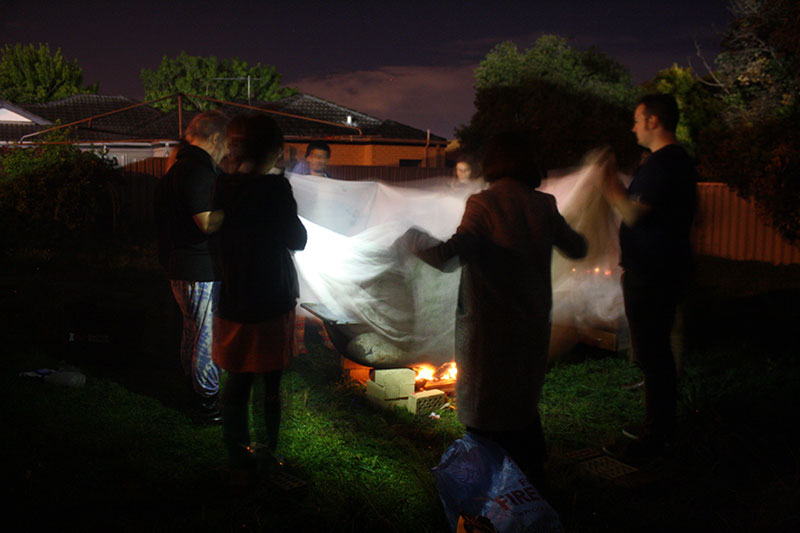
This exhibition highlights a variety of approaches in the selection and curatorial positioning of works of art. There is attention given to Indigenous perspectives and the need for greater connection to the land in works by Katie West, Mei Saraswati, Rebecca Orchard and collaborators Matt Aitkin and Noel Nannup. Interspecies proximity, intimacy and entanglements between human and animal, insect and plant life are evident in the works of Pony Express, Perdita Phillips, Mike Bianco, Cat Jones and collaborators Peter and Molly. Human ecology, ritual and belonging are explored by Andrew Christie, The ‘Cene and Rose Megirian. Global political ecologies are addressed by Nathan Beard and Tim Burns. And the distribution of the senses through technology is claimed by Stelarc. Exhibition co-curator Andrew Varano (working alongside Leigh Robb and Nadia Johnson) hopes that the exhibition opens up “a slow meditative space for people to think through these themes”.[2]
Meditation as mediation is invited by the first work encountered, Decolonist by Katie West. Projected onto a large screen at the entrance of the space this is a fluid abstract animation with a meditative voiceover. It soothes the viewer into consideration of Australia and being Australian as West asks us to “decolonise the self”. But the action of standing before this piece and taking it in is disrupted by its placement in the doorway. Literally functioning as a screen to the rest of the exhibition, it is subject to numerous interruptions from people passing through and light washing out the projection each time the sliding front doors open, muddying its message and power.
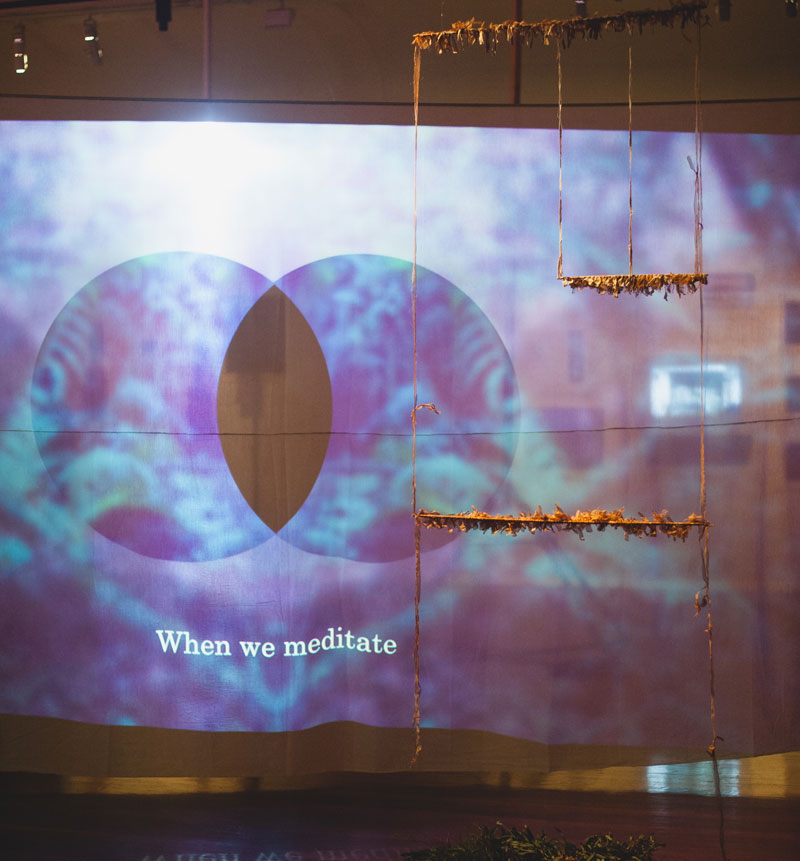
The ecological impact of humanity and its instrumentalities, at the core of questions surrounding the Anthropocene, is highlighted in the multi-channel video and sound installation The Superior Animal by artistic collaborators Peter and Molly. These artists question “how intrinsic and instrumental values are assigned to animals by humans”. They impassively subject themselves to leaches, bathe with octopi as head adornments that leak black ink and outrageously embellish themselves in pearls on a pearl farm. In each of these visually arresting scenarios the human body is used as a way to question and complicate the instrumentality of the non-human and explore the various interrelations of the non-human and human.
When considering non-human entities in all their physicality the only work in the show to house a living ecology within the gallery is Bee Bed by Mike Bianco. Inspired by the Ukrainian folk tradition of beekeepers sleeping with their bees, Bianco invites us to lie down with bees, take in their warmth, their persistent buzz and heady honey scent. The bees are free to enter and exit the gallery through an acrylic tube and it is possible to lie down on a rather unforgiving wooden “bed” and edge your head into an enclosed space to experience the bee ecology. This is a pleasant and unique gallery experience. Bianco describes it as a “radical encounter for interspecies intimacy between humans and honey bees”.[3] But I would question how it could be considered intimate if you hug someone and they don’t hug you back? The bees have no say in the proposed act of intimacy, there is no opportunity for feedback; the bees are just going about their business being bees. As with the parallel eco-sexual project of Pony Express, where erotic encounters are suggested with plant life, it is more a question of proximity than intimacy. Proximity is one step towards intimacy, but there is a long way to go to go for us to reach actual intimate interrelations with our fellow plant and insect life on this planet.
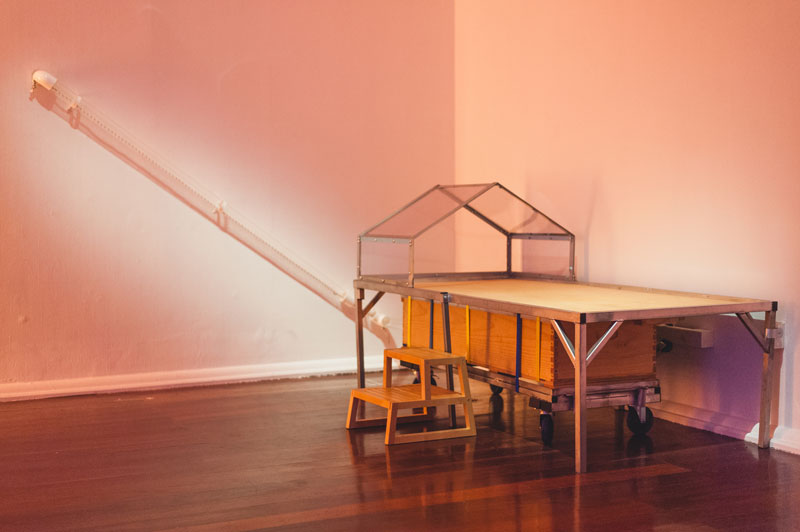
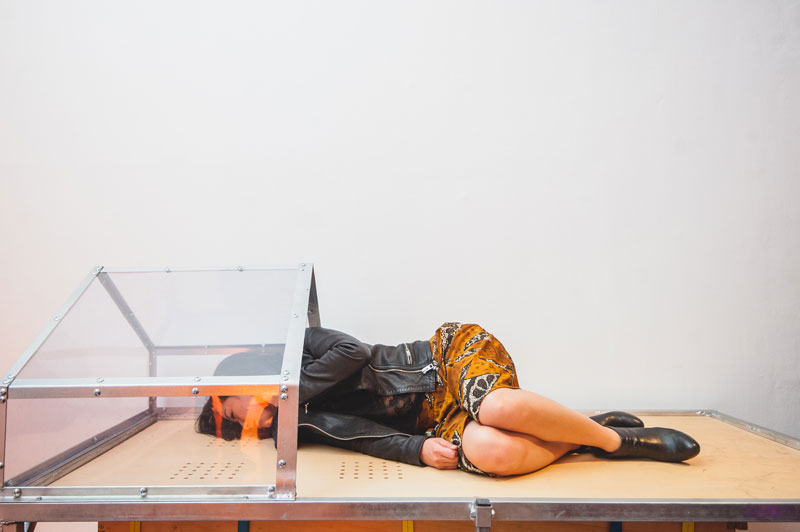
When it comes to politically radical art, one of the only artists to explore this terrain is Tim Burns, with the display of a collection of his prints and a video, dating from 1977 to 2016. These works address such issues as climate change, fracking and surveillance. Burns was heard to bemoan the absence of radicalism throughout the exhibition and in a gesture of protest on the night of the second opening (the week following the Pica Salon), he sprayed his prints with a lurid pink paint and was removed from the premises. This has not happened to Burns since 1973 and the core of his sentiment points to a real concern with the show.
Overall Radical Ecologies is gentle in its approach and does not live up to the provocation of the title. Nor does it challenge us with a “mind-shift” as the media release ambitiously states. The exhibition does not push boundaries through entertaining ideas of radical disruptive ecologies or new directions in art making and presenting. It could, for instance, have included more actual “life” in the gallery, as ambitiously pursued by Perth-based SymbioticA, who are world pioneers in embracing biological arts. It could have made greater efforts to refuse privileging the anthropocentric, with counter-hegemonic ideas of body and being to get to the core of the question of what ecology means today and into the future. Closer attention to Indigenous knowledge and care of the land and its life forms would be have also been a good place to start. Many of the works fail to reach beyond a more aestheticised view of ecological or Anthropocene thinking. I would have liked to see these provocative ideas carried much further in terms of art actions and ideas.
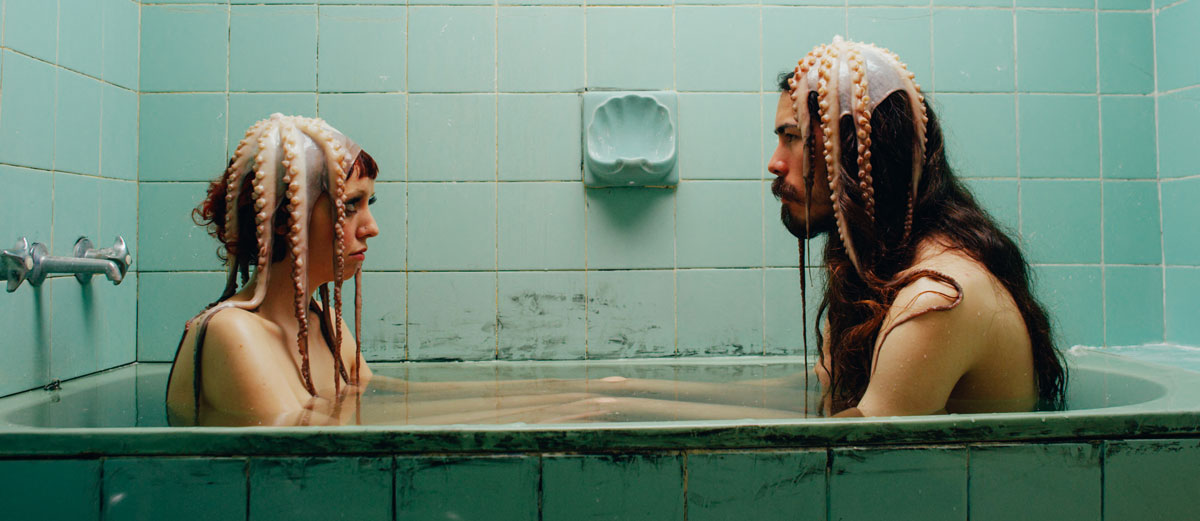
Footnotes
- ^ William K. Carroll, “What Radicalism Means in the 21st Century” in Review of Radical Political Economics, April 2015: https://www.academia.edu/12553014/What_Radical_Means_in_the_21st_Century_Robust_Radicalism.
- ^ Radical Ecologies Curator Interview: Andrew Varano: https://www.youtube.com/watch?v=rEzFtBfwIF4
- ^ Radical Ecologies Artist Interview: Mike Bianco: https://www.youtube.com/watch?v=-QHebxkbkpQ

